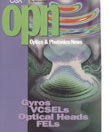
May 1998 Issue
- Fiber Optic Gyroscopes: Light is Better
- VCSELs Advances and Future Prospects
- Microscopes for the Sub-Visible: Scanning the Near-Field in the Microwave to IR
- Free-Electron Lasers: Bright Light Sources for the Future
- Making Optics Express Movies
- Scanning Optical Microscopy, Part I
- Diffractive Magnifier
- Optics for the Fish, Part II
- Browse all Issues
Feature Articles
Fiber Optic Gyroscopes: Light is Better
Fiber optic gyroscopes are becoming prevalent in the marketplace especially in automobile navigation systems in Japan. This article tells how they work, what they do, and how they're used.
VCSELs Advances and Future Prospects
Semiconductor diode lasers pervade our society in both the telecom and consumer electronics industry. A particular kind of laser diode — a verticle-cavity surface-emitting laser — is revolutionizing the capabilities of these tiny structures and their potential markets.
by W.K. BurnsMicroscopes for the Sub-Visible: Scanning the Near-Field in the Microwave to IR
Conventional microscopy is a mainstay of science and technology, yet it uses only the visible fraction of the spectrum, leaving the longer wavelength regime largely unexplored. With tiny antennas and scanning probe microscopes, however, researchers are beginning to shed new light onto this once-invisible world.
by Daniel van der WeideFree-Electron Lasers: Bright Light Sources for the Future
FREE-ELECTRON LASERS (FELs) WILL BE AN IMPORTANT COMPONENT IN THE NEXT GENERATION OF LIGHT SOURCES WHERE THE PRODUCTION OF COHERENT, SHORT PULSE RADIATION AT X-RAY WAVELENGTHS IS DESIRED. O'SHEA DETAILS THE MECHANICS OF FELs THEN TAKES A LOOK AT CURRENT AND FUTURE APPLICATIONS.
by Patrick G. O'SheaMaking Optics Express Movies
One great advantage to publishing online, in an all electronic journal such as Optics Express (OpEx), is the ability to use sound and/or video to convey a concept. Currently, about 25% of OpEx articles use multimedia. However, is such multimedia content consistent with an archival journal publication?
by Neal Gallagher and Frank HarrisScanning Optical Microscopy, Part I
Diffraction-limited focusing of a laser beam for the purpose of scanning a surface to either explore or modify that surface is the basis of several important technologies. Examples include scanning optical microscopy, optical disk data storage, and laser printing. The size of the focused spot and the corresponding depth of focus are important factors in determining the performance characteristics of these systems. This month's column is part one of a two-part series that examines methods of forming the focused spot, and attempts to clarify the relation between the spot size and the depth of focus. The first part addresses imaging through air, immersion oil, and cover plates. Next month's column will continue this discussion, concentrating on imaging through solid immersion lenses.
by Masud Mansuripur, Lifeng Li, Wei-Hung YehDiffractive Magnifier
Diffractive optical elements have a number of theoretical advantages over conventional lenses, including a negative Abbe number, highly abnormal partial dispersion, and zero petzval sum contribution. However, their use in visible light applications has to date been limited because of stray light problems. One application where this seems to be less of an issue is in visual systems such as eyepieces and magnifiers.
by J. Brian CaldwellOptics for the Fish, Part II
Last month I introduced a series of experiments that use water-filled fishtanks to show refraction, reflection, and scattering. This month, I discuss some water-based optical systems that can be demonstrated using your fishtank. The first, "the luminous fountain," is an optical fiber made out of water; the second is an optical communication system that I call an "optical water-guide." The same equipment and supplies described last month are used for the first experiment; for the second, you'll need to procure a modulatable laser, a photodetector, and an audio amplifier with a speaker.
by R. John Koshel

![A multiplexed image of a human tonsil acquired. [NIAID] using the iterative bleaching extends multiplexity (IBEX) method.](https://opnmedia.blob.core.windows.net/$web/opn/media/images/articles/2024/0424/departments/202404-cover-web.jpg?ext=.jpg)
